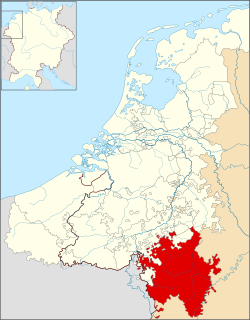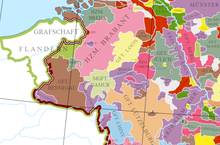This article needs additional citations for verification. (April 2016) |
County of Luxembourg Grofschaft Lëtzebuerg (Luxembourgish) Grafschaft Luxemburg (German) Comté de Luxembourg (French) Comitatus Luxemburgensis (Latin) | |||||||||
|---|---|---|---|---|---|---|---|---|---|
| 1059–1353 | |||||||||
 Luxembourg within the Low Countries, 1350 | |||||||||
| Status | State of the Holy Roman Empire | ||||||||
| Capital | Luxembourg | ||||||||
| Common languages | |||||||||
| Religion | Roman Catholicism | ||||||||
| Government | Feudal monarchy | ||||||||
| Count of Luxembourg | |||||||||
• 1059–1086 | Conrad I (first) | ||||||||
• 1346–1353 | Charles IV (last) | ||||||||
| Historical era | Middle Ages | ||||||||
• Obtained by Sigfried | 963 | ||||||||
• Acquired by House of Ardenne–Luxembourg | 1059 | ||||||||
• Raised to county | 1214 | ||||||||
• Raised to duchy by the Emperor | 1353 | ||||||||
• Held by the Dukes of Burgundy | 1443 | ||||||||
• To Habsburg | 1482 | ||||||||
• Occupied by France | 1795 | ||||||||
• Grand Duchy re-established | 1815 | ||||||||
| ISO 3166 code | LU | ||||||||
| |||||||||
| Today part of | |||||||||


The County of Luxembourg (French: Luxembourg; Luxembourgish: Lëtzebuerg) was a State of the Holy Roman Empire. It arose from medieval Lucilinburhuc ("Little Fortress")[1] Castle in the present-day City of Luxembourg, purchased by Siegfried, Count of the Ardennes in 963. His descendants of the Ardennes–Luxembourg dynasty began to call themselves Counts of Luxembourg from the 11th century onwards. The House of Luxembourg, a cadet branch of the Dukes of Limburg, became one of the most important political forces of the 14th century, contending with the House of Habsburg for supremacy in the Holy Roman Empire.
- ^ "Luxembourg | national capital, Luxembourg". Encyclopædia Britannica. Retrieved 27 October 2016.
